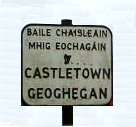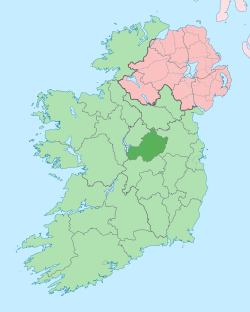Castletown Geoghegan
Castletown Geoghegan (Irish: Baile Chaisleáin Mag Eochagán)[2] is a town in County Westmeath, Ireland, and lies south west of Lough Ennell near the county town of Mullingar. Castletown was the seat of the Geoghegan family of the medieval Barony of Moycashel in County Westmeath.
Castletown Geoghegan Baile Chaisleáin Mag Eochagán | |
|---|---|
Town | |
Castletown in winter | |
 Castletown Geoghegan Location in Ireland | |
| Coordinates: 53°26′49″N 7°29′20″W | |
| Country | Ireland |
| Province | Leinster |
| County | County Westmeath |
| Elevation | 95 m (312 ft) |
| Population (2016)[1] | 141 |
| Time zone | UTC+0 (WET) |
| • Summer (DST) | UTC-1 (IST (WEST)) |
| Irish Grid Reference | N337442 |
History

The Mac Eochagáin family are descended from Fiacha, son of Niall Naoi Noigíallach. Niall is reputed to have captured and enslaved the teenage Magnus Succetus - who later returned to preach Christianity as Patricius - in a raid on the Cumbrian or Welsh coast. The descendants of Niall's son Fiacha (Fiachu Fiachrach) were collectively known as Cenel Fhiachaigh, of the southern Ui Neill (later anglicised as Kenaleagh and Kindalane).
The Geoghegan family were major landholders in south Westmeath maintained a peaceful co existence with the Tudor reconquest through surrender and regrant under with their leader accepting the Captaincy from Elizabeth I. As the reign of the Stuarts led to the Civil War and the appalling events of 1641 to the Cromwellian invasion, the family suffered great losses following the Down Survey and ensuing Plantations that followed on. The later War of the Three Kingdoms finalized the confiscation. They lost a considerable portion their estates to Gustavus Lambart (later created Earl of Cavan) through confiscation even prior to the final publication of the Down Survey. The abundant productivity of the rich grazing being self-evident, the Lambarts of Kilcoursey contrived to procure much of it very early in the process.
In the general political reform following the Tudor Conquest, the somewhat reduced medieval barony was subject to the 'Surrender and Regrant' process and the adroit Geoghegan family Chief Kedagh complied and was accorded the title of 'Captain' Geoghegan in the reign of Queen Elizabeth I. He resided in the principal Geoghegan castle of the barony which was located in the village at this time.
The Restoration resettlement Acts of the late 17th century indeed favored the retention of land by some of the recently ensconced Cromwellian Adventurers and Undertakers and some to their traditional owners. Consequently, some relatively small holdings of the rich grazing lakeland was restored to the Geoghegans. It did not help the case for a greater degree restoration of Geoghegan land that the chieftain Bryan and many of his allies of the "Irish of Meath" coalition refused to sign the mandatory pledges and undertakings of fealty to the new regime of William and Mary, Parliament and the established church. Political acumen, however, was not their strong suit. The Geoghegan leaders, along with many more native landholders were mostly headed for exile and Connaught (where some of them reverted to their patronymic surname of O'Neill).
The Geoghegan family had led a group of local Gaelic chieftains in a notable and powerful long term alliance. The 'Irish of Meath' included the O'Melaghlin (McLaughlin), O'Maolmhuidhe (Molloy), Kearney, Fox, Dalton and Brennan families. These native septs all suffered heavy property confiscation after the Confederate / Commonwealth Wars. They are prominent in the Annals of Clonmacnoise, a notable collection of historical records. Many families received offers of Surrender and Regrant deals after the Restoration, but some families rejected the terms. Recalcitrants were reluctant to adhere to the terms of oaths of fealty required. The Annals collection was translated from the original Irish into Elizabethan English by Conall Geoghegan, a 16th-century Franciscan friar.
Abbe James Mac Geoghegan, born in nearby Uisneach, wrote his celebrated Mac Geoghegan's History of Ireland at Chartres in France in the 18th century. This history became Eamon De Valera's desk companion for his political life.[3]
The surrounding territories were held by the Tyrrells of Fartullagh, the Dillon's of Drumrany (which lay to the west between Moate and Athlone). The Nugents of Delvin, later Lords Delvin and Marquess of Westmeath and the Tuites of Sonagh were to the east.
Sport
Among the most popular local sports are G.A.A. football and hurling. The Castletown Geoghegan Hurling Club sports the black and amber stripe. It was introduced by a Kilkenny railway employee, and became a tradition here. The club holds 13 senior hurling titles, 1923, 1956, 1957, 1958, 1960, 1964, 1979, 1982, 1986, 1990, 2004, 2013 and 2017. The club has a very strong junior component. It achieved two National titles at under the 14 level in 2007 and 2010. The club crest depicts the ruins of a castle on the shores of Lough Ennel with the sun rising in the background.
The 1946 Epsom Derby winner, Airborne was bred near the village in 1943.[4] Oscar Time was trained locally by Martin Lynch, the horse trainer and jockey.
See also
- List of towns and villages in Ireland
- Dermot Farrell
- George Boyd-Rochfort, VC, is buried in Castletown Old Churchyard
- Alan Mangan, Gaelic footballer, is from Castletown Geoghegan[5]
References
- "Sapmap Area - Settlements - Castletown Geoghegan". Census 2016. Central Statistics Office. April 2016. Retrieved 16 March 2020.
- "Baile Chaisleáin Mag Eochagán/Castletown Geoghegan". Placenames Database of Ireland. Government of Ireland. Retrieved 25 June 2011.
- "Geoghegan Family". irishmidlandsancestry.com. Archived from the original on 18 February 2007.
- Armytage, Marcus (2011-03-31). "Oscar Time primed for his chance in the Grand National spotlight". London: Telegraph. Retrieved 2011-11-12.
- "Mangan 'up to the challenge' of retaining Labour seat". Westmeath Examiner. 6 July 2018.
